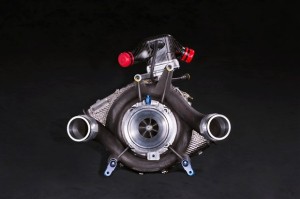2014 is going to bring sweeping changes for the technical regulations of Formula 1 racing. Teams are moving from 2.4 liter naturally aspirated V8’s to turbocharged 1.6 liter V6’s with two electric motors. The first is the familiar crank driven mechanical energy recovery system and the second is a thermal energy recovery system where an electric motor is added between the turbine and compressor of the turbo. Ferrari’s intro video  shows a “uniturbo” similar to the ones used on the Audi TDI Le Mans racers where the turbine housing has two entry passages for the opposing banks of the V6. The electric motor can act as a generator producing electrical energy from the turbine or it can work as a motor to help spool the turbo into boost efficient rpm’s. Integrating the engine so thoroughly with these new hybrid technologies calls for some new terminology. “Engine” is no longer an adequate description of the cars’ power sources. The whole system is now being referred to as a powertrain and KERS (Kinetic Energy Recovery System) is now referred to as ERS (Energy Recovery System) since it will now also be harvesting thermal energy. New rules regarding restricted fuel capacity and flow rates and better engine durability accompany the new powertrain architecture. The energy management strategies are going to play a huge role in team strategies for the upcoming season. Hopefully most of this performance hybrid technology and acceptance will trickle down into affordable street cars pretty soon.
shows a “uniturbo” similar to the ones used on the Audi TDI Le Mans racers where the turbine housing has two entry passages for the opposing banks of the V6. The electric motor can act as a generator producing electrical energy from the turbine or it can work as a motor to help spool the turbo into boost efficient rpm’s. Integrating the engine so thoroughly with these new hybrid technologies calls for some new terminology. “Engine” is no longer an adequate description of the cars’ power sources. The whole system is now being referred to as a powertrain and KERS (Kinetic Energy Recovery System) is now referred to as ERS (Energy Recovery System) since it will now also be harvesting thermal energy. New rules regarding restricted fuel capacity and flow rates and better engine durability accompany the new powertrain architecture. The energy management strategies are going to play a huge role in team strategies for the upcoming season. Hopefully most of this performance hybrid technology and acceptance will trickle down into affordable street cars pretty soon.
Source: Auto Broadcast Video on YouTube
